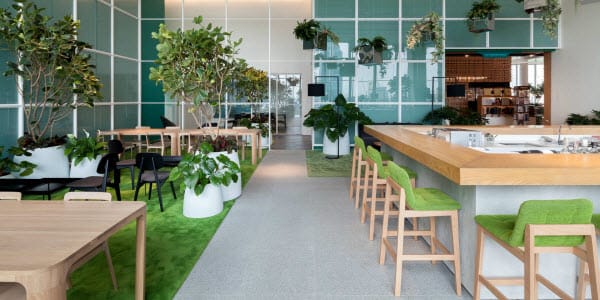
10 Restaurant and Bar Trends You Need to Know in 2025
Introduction:
As we step into 2025, the restaurant and bar industry is poised for significant changes. Understanding these trends will be crucial for staying competitive in a rapidly evolving market. From the adoption of new technologies to shifts in consumer preferences, the following trends will shape the future of the industry. By staying ahead of these developments, restaurants, bars, and cafes can ensure their success in the coming year.
1. Hyper-Personalization of Dining Experiences
In 2025, hyper-personalization will be more than just a buzzword; it will be a driving force in the restaurant and bar industry. Customers increasingly expect personalized experiences that cater to their individual tastes and preferences. Leveraging data analytics, restaurants can now customize menus, suggest personalized drink pairings, and create unique dining experiences tailored to each guest. For instance, using data from previous visits, a restaurant might recommend a specific wine that aligns with a customer’s preferred flavor profile. This level of personalization not only enhances customer satisfaction but also fosters loyalty.
To implement hyper-personalization effectively, restaurants and bars must invest in technology that captures and analyzes customer data. This includes everything from digital reservation systems to loyalty programs that track customer preferences. The insights gained from this data can then be used to craft personalized experiences, from customized menus to targeted marketing campaigns. Establishments that excel in personalization will see higher customer retention rates and increased profitability.
Moreover, personalization extends beyond just food and drink. It can also involve the ambiance and setting. For example, a restaurant might adjust lighting and music based on a customer's previous preferences. By creating an environment that feels tailor-made, establishments can turn a one-time visitor into a regular patron.

2. Sustainability Takes Center Stage
Sustainability is no longer just an option; it’s a necessity for the restaurant and bar industry in 2025. With increasing consumer awareness about environmental issues, customers are demanding more sustainable practices. Restaurants and bars that prioritize sustainability will not only meet customer expectations but also benefit from cost savings and brand loyalty.
One key area of focus is sourcing ingredients locally and organically. This reduces the carbon footprint associated with transportation and supports local farmers. Additionally, reducing food waste through better inventory management and offering seasonal menus that align with local produce availability are effective strategies. For example, a bar might introduce a rotating cocktail menu that highlights seasonal ingredients, reducing waste and keeping the menu fresh and exciting.
Beyond sourcing and waste reduction, sustainability efforts can also include energy-efficient kitchen equipment, eco-friendly packaging, and water conservation measures. By communicating these practices to customers, restaurants and bars can enhance their brand image and attract a more conscious clientele. The emphasis on sustainability will not only contribute to a healthier planet but also position businesses as leaders in a growing movement towards responsible consumption.

3. Rise of Plant-Based and Alternative Proteins
The rise of plant-based and alternative proteins is set to continue in 2025 as more consumers adopt flexitarian and plant-based diets. This trend is driven by health, environmental, and ethical considerations, making it essential for restaurants and bars to expand their plant-based offerings. The challenge for chefs and restaurateurs will be to create innovative, flavorful dishes that appeal not only to vegans and vegetarians but also to mainstream diners.
One practical approach is to incorporate plant-based proteins into traditional dishes. For instance, a classic burger can be offered with a plant-based patty option that rivals its meat counterpart in taste and texture. Similarly, bars can introduce plant-based mixers or non-dairy alternatives for popular cocktails, catering to those with dietary restrictions while still delivering a satisfying experience.
In addition to expanding menu options, restaurants and bars can also educate their customers on the benefits of plant-based eating. This could be through menu descriptions, social media campaigns, or in-house events like plant-based cooking classes. By positioning themselves as leaders in this space, establishments can attract a wider audience and contribute to a more sustainable future.

4. Integration of Advanced Technology
Technology continues to revolutionize the restaurant and bar industry, and in 2025, its integration will be more critical than ever. From AI-powered customer service to automated kitchen operations, technology offers numerous benefits, including increased efficiency, enhanced customer experience, and improved decision-making processes.
Restaurants and bars that embrace technology can streamline operations and reduce costs. For example, AI-driven chatbots can handle reservations and customer inquiries, freeing up staff to focus on in-person interactions. In the kitchen, automated equipment can ensure consistency in food preparation, reduce waste, and optimize energy usage. These advancements not only improve efficiency but also allow businesses to operate more sustainably.
On the customer-facing side, digital menus and contactless payment systems will become the norm, offering convenience and safety. Restaurants can also leverage data from these systems to gain insights into customer preferences and behavior, enabling more targeted marketing and personalized experiences. The key to success will be in choosing the right technology solutions that align with the specific needs of the business and its customers.

5. Experiential Dining Takes the Lead
In 2025, dining out will increasingly become about the experience rather than just the food. Restaurants and bars that offer unique, immersive experiences will stand out in a crowded market. Whether it’s through themed events, interactive cooking demonstrations, or live entertainment, creating memorable moments will be key to attracting and retaining customers.
Experiential dining can take many forms, from pop-up restaurants to immersive dining experiences that engage all the senses. For example, a bar might host a cocktail-making workshop where guests can learn to craft their favorite drinks, or a restaurant might offer a chef’s table experience where diners can interact with the chef and learn about the ingredients and techniques used in their meal.
These experiences not only differentiate a restaurant or bar from its competitors but also create a deeper connection with customers. By offering something beyond the typical dining experience, establishments can foster loyalty and encourage repeat visits. As the trend towards experiential dining grows, those who can innovate and offer something unique will thrive in the industry.

6. Health-Conscious Menus
Health and wellness will continue to be major drivers of consumer behavior in 2025. As more people prioritize their health, restaurants and bars will need to offer menus that cater to this demand. This includes not only providing healthier options but also being transparent about ingredients and nutritional information.
To appeal to health-conscious diners, establishments can introduce nutrient-dense dishes that are low in calories but high in flavor. Superfoods, whole grains, and plant-based options will be particularly popular. Additionally, offering gluten-free, dairy-free, and low-sugar alternatives can cater to those with dietary restrictions. For example, a café might introduce a range of smoothies packed with superfoods like acai, chia seeds, and spinach, appealing to health-focused customers.
In addition to menu offerings, the presentation of health-related information will also be important. Providing clear, easy-to-understand nutritional information can help customers make informed choices. Restaurants and bars that can combine health-conscious options with delicious flavors will be well-positioned to attract and retain customers in 2025.

7. Emphasis on Local and Authentic Cuisine
As global culinary trends continue to evolve, there will be a renewed emphasis on local and authentic cuisine in 2025. Diners are increasingly seeking out restaurants and bars that offer genuine, region-specific experiences. This trend is driven by a desire to connect with the culture and heritage of a place through its food, as well as a growing interest in supporting local businesses and producers.
Restaurants that highlight local ingredients and traditional cooking methods will stand out. For example, a restaurant might offer a menu that celebrates the flavors of a specific region, using ingredients sourced directly from local farmers and producers. Similarly, bars might create cocktails that showcase local spirits and flavors, providing customers with a taste of the local culture.
In addition to offering authentic cuisine, the ambiance of the restaurant or bar can also reflect the local culture. Decor, music, and even the service style can be tailored to create an immersive experience that transports diners to a different place. By embracing local and authentic cuisine, restaurants and bars can offer something unique that resonates with both locals and tourists.

8. Flexible Dining Spaces
The events of the past few years have reshaped the way people dine, and flexibility will be key for restaurants and bars in 2025. Customers are looking for dining options that accommodate different needs, whether that’s outdoor seating, private dining areas, or flexible layouts that can be adapted for various group sizes and occasions. Establishments that can offer versatile dining spaces will be better equipped to meet these changing demands.
Outdoor dining, in particular, has become increasingly popular, and many customers now prefer it as a safer and more enjoyable option. Restaurants and bars that can create inviting outdoor spaces, with comfortable seating and weather-resistant features, will attract more patrons. Additionally, flexible indoor spaces that can be reconfigured for private events, family gatherings, or casual dining will offer greater versatility.
To maximize the use of space, some establishments are experimenting with multi-functional areas that can serve different purposes at different times of the day. For example, a café might transform into a cocktail lounge in the evening, or a dining area might be converted into a space for live entertainment. This flexibility not only enhances the customer experience but also allows businesses to optimize their revenue potential throughout the day.

9. Focus on Mental Wellness
Mental wellness has become an increasingly important topic, and in 2025, restaurants and bars will play a role in creating spaces that promote relaxation and well-being. Customers are seeking more than just a meal; they’re looking for environments that help them unwind and escape the stresses of daily life. Establishments that prioritize mental wellness will attract customers looking for a holistic dining experience.
Creating a calming atmosphere can involve various elements, such as ambient lighting, soothing music, and comfortable seating. For example, a restaurant might use soft, warm lighting to create a cozy, inviting space, while a bar might play calming music that encourages patrons to relax and enjoy their drinks. Additionally, offering wellness-focused menu options, such as herbal teas or mood-boosting foods, can further enhance the experience.
Beyond the physical environment, mental wellness can also be promoted through mindful service practices. Training staff to be attentive and empathetic, while maintaining a calm and pleasant demeanor, can significantly impact the overall experience. By creating spaces that prioritize mental wellness, restaurants and bars can offer a unique value proposition that resonates with today’s health-conscious consumers.

10. Embracing Ethical Consumption
Ethical consumption is becoming increasingly important to consumers, and in 2025, restaurants and bars will need to align with this value. Customers are not only interested in the quality of the food they consume but also in the ethical implications of how it is sourced and prepared. Establishments that emphasize fair trade practices, humane treatment of animals, and transparency in sourcing will attract socially conscious diners.
One way to embrace ethical consumption is by highlighting these practices on the menu and in marketing materials. For instance, a restaurant might note that its coffee is sourced from fair trade farms, or that its meat is sourced from suppliers who adhere to humane farming practices. Transparency in sourcing, coupled with a commitment to ethical practices, can differentiate a business in a crowded market.
Additionally, offering plant-based and sustainably sourced options can appeal to customers who prioritize ethical consumption. By aligning with these values, restaurants and bars can build a loyal customer base that appreciates and supports their ethical stance. As consumers become more discerning about where their food comes from, establishments that embrace ethical consumption will be well-positioned for success.
Conclusion:
As we move into 2025, staying ahead of these trends will be essential for restaurants, bars, and cafes looking to remain competitive. By embracing innovation, sustainability, and customer-centric practices, your establishment can thrive in the ever-evolving landscape of the food and beverage industry.
